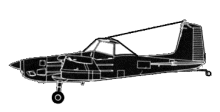
ASN Wikibase Occurrence # 286794
This information is added by users of ASN. Neither ASN nor the Flight Safety Foundation are responsible for the completeness or correctness of this information.
If you feel this information is incomplete or incorrect, you can submit corrected information.
| Date: | Thursday 16 July 2009 |
| Time: | 05:40 LT |
| Type: |  Cessna A188B |
| Owner/operator: | Nicolet Air LLC |
| Registration: | N9747G |
| MSN: | 18801587T |
| Total airframe hrs: | 2211 hours |
| Engine model: | Continental IO-520-D |
| Fatalities: | Fatalities: 0 / Occupants: 1 |
| Aircraft damage: | Substantial |
| Category: | Accident |
| Location: | Suring, Wisconsin -
 United States of America United States of America
|
| Phase: | Manoeuvring (airshow, firefighting, ag.ops.) |
| Nature: | Agricultural |
| Departure airport: | Suring, WI |
| Private Field, WI | |
| Investigating agency: | NTSB |
| Confidence Rating: |
The pilot reported that the engine began to run very rough during a turn at low altitude. The engine suddenly seized so he made an emergency landing to a wheat field. During the landing, the left main gear collapsed and the left wing and nose of the aircraft dug into the soft soil, sustaining substantial damage. A teardown inspection of the engine revealed fretting wear scars on the crankcase backbone between the number two and three main bearing supports, and the number one, two, and three camshaft journal supports. The number one, two, three, four, and five main crankshaft main bearing supports exhibited fretting wear scars, and the number two and three supports exhibited mechanical damage from bearing shift and rotation. Additionally, the number two intermediate crankshaft main bearings had extruded from their crankshaft positions in the left and right case halves. An unapproved red sealant had been applied to the crankcase backbone. The above signatures are all consistent with an engine crankcase assembly that had lost its through-bolt torque. The crankshaft was fractured through at the number four short cheek between the number two main bearing journal and the number three connecting rod journal. A metallurgical examination of the fracture surface revealed crack arrest marks, which were indicative of a fatigue fracture which emanated from the surface of the number two main bearing journal. The heat treatment of the crankshaft met the manufacturer's specifications. An examination of the engine logbooks revealed that the engine's total time was about 1,778 hours and it had about 500 hours since the last major overhaul. The engine's last overhaul was conducted on September 30, 1986, almost 23 years since the last major overhaul. The engine manufacturer recommends that when the aircraft is used in aerial spraying, the engine be overhauled after an accumulation of 1,200 hours or twelve (12) years, whichever occurs first.
Probable Cause: A loss of engine power resulting from the fatigue failure of the crankshaft due to the loss of engine case through-bolt torque. Contributing to the engine failure was the operator's failure to overhaul the engine in accordance with the manufacturer's recommended guidelines.
Accident investigation:
 |
|
Sources:
NTSB CEN09LA447
History of this aircraft
Other occurrences involving this aircraft
| 14 September 1992 | N9747G | Dahl Airspray, Inc. | 0 | Cogswell, ND |  |
sub |
Location
Revision history:
| Date/time | Contributor | Updates |
|---|---|---|
| 03-Oct-2022 16:12 | ASN Update Bot | Added |
Corrections or additions? ... Edit this accident description
The Aviation Safety Network is an exclusive service provided by:


 ©2024 Flight Safety Foundation
©2024 Flight Safety Foundation